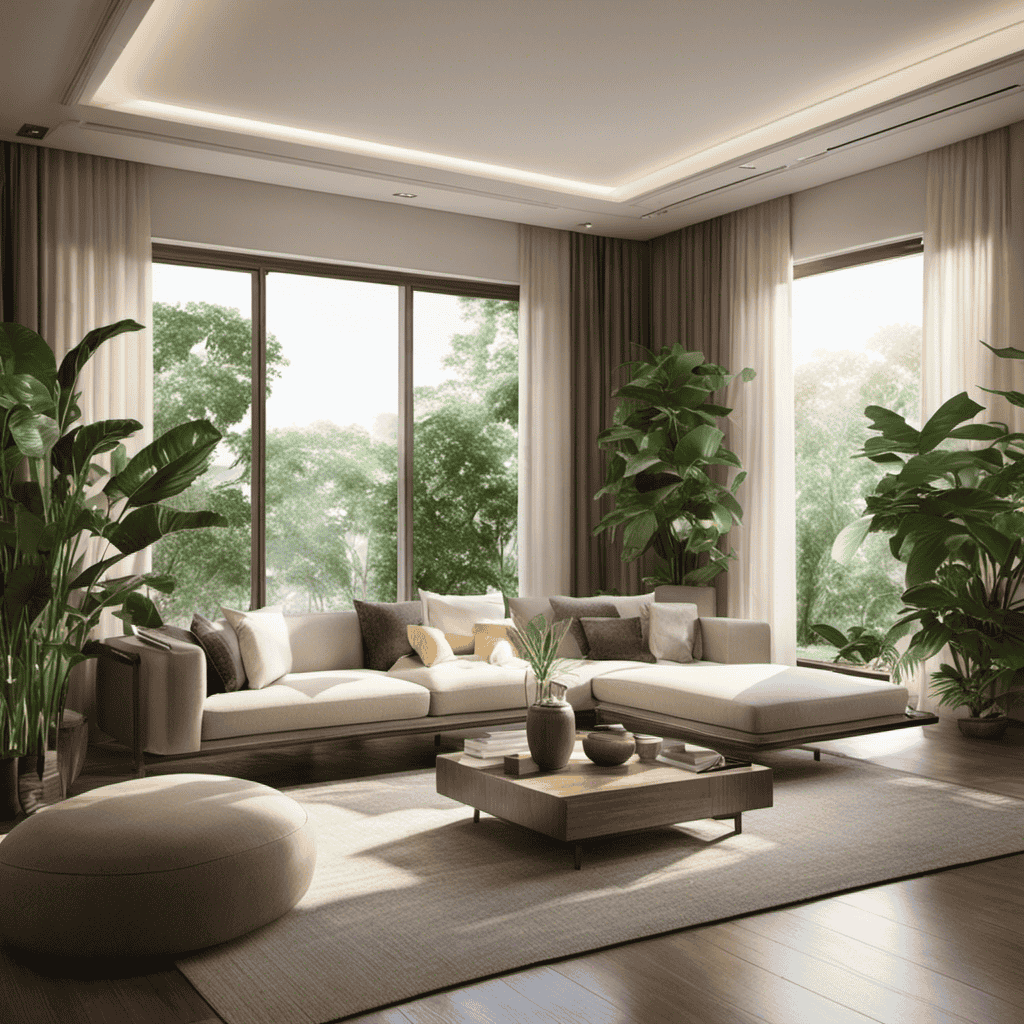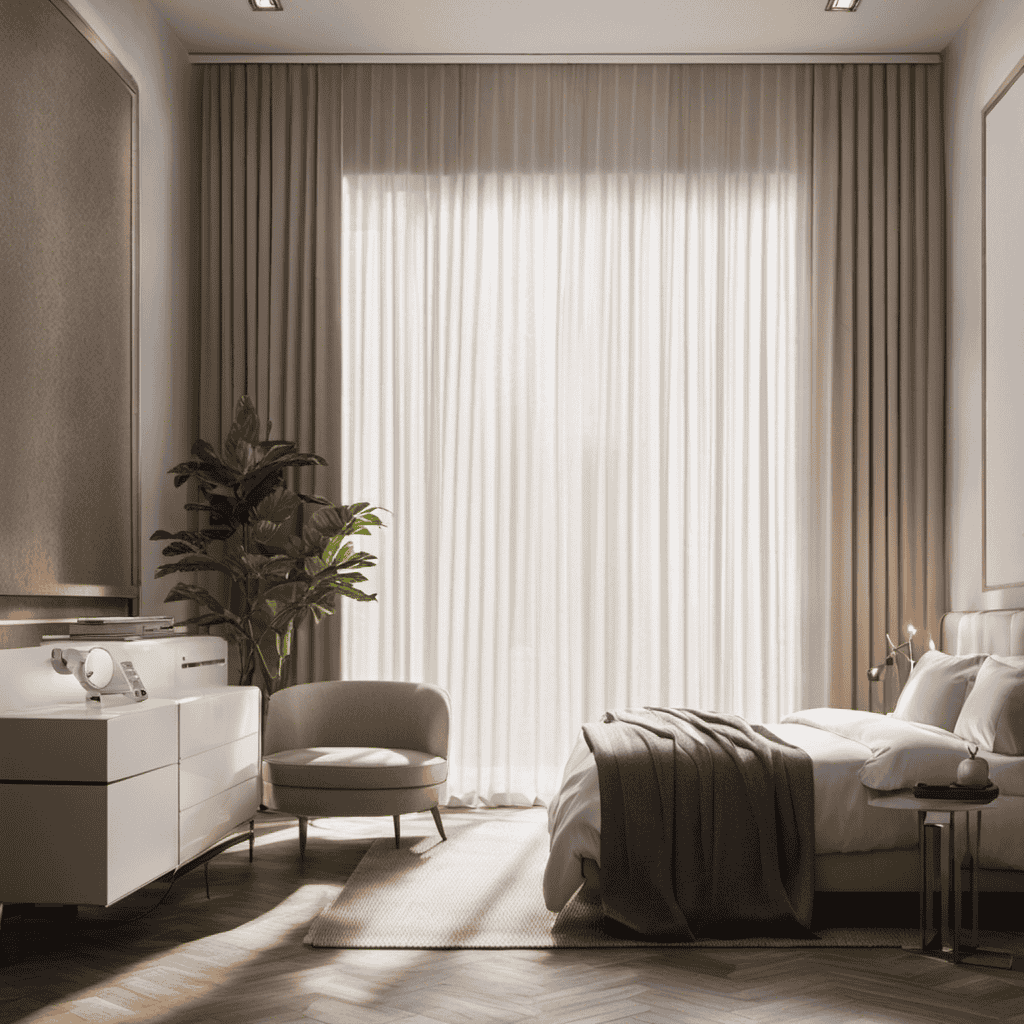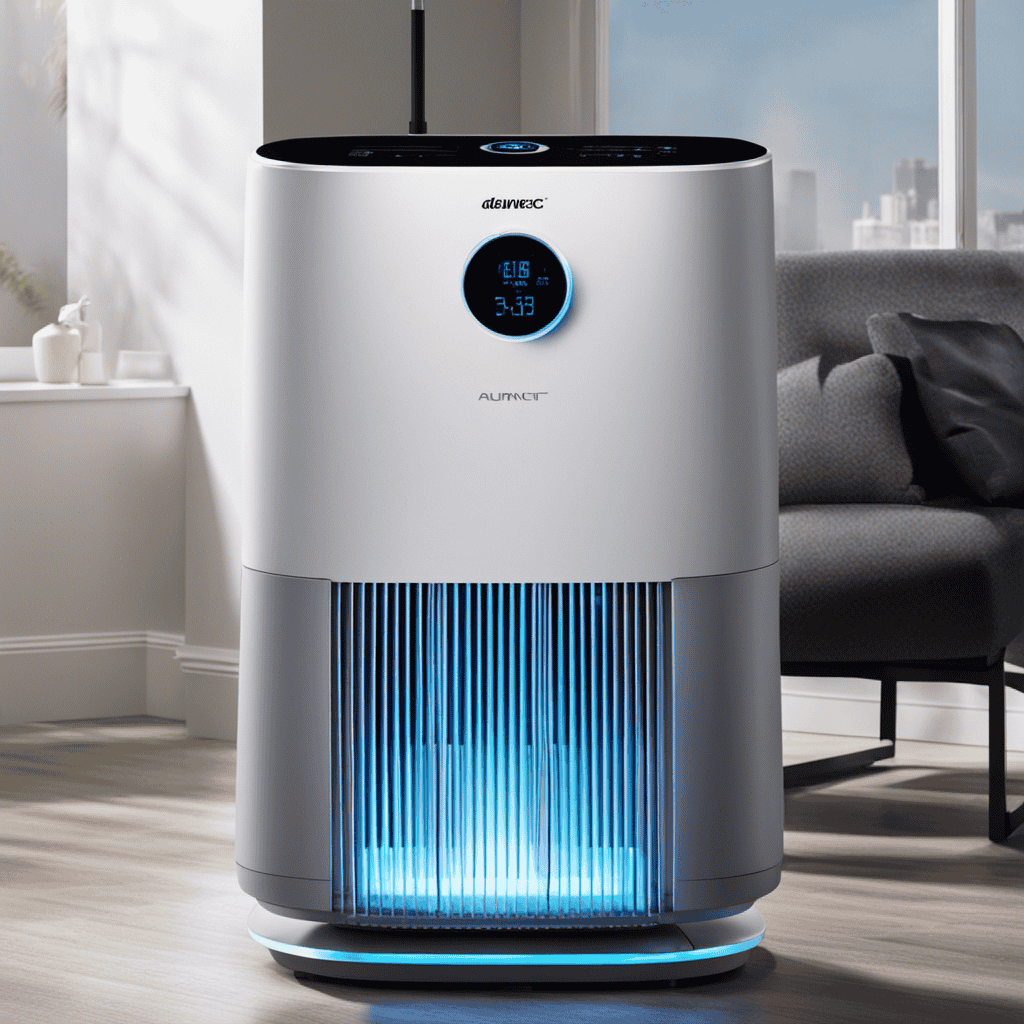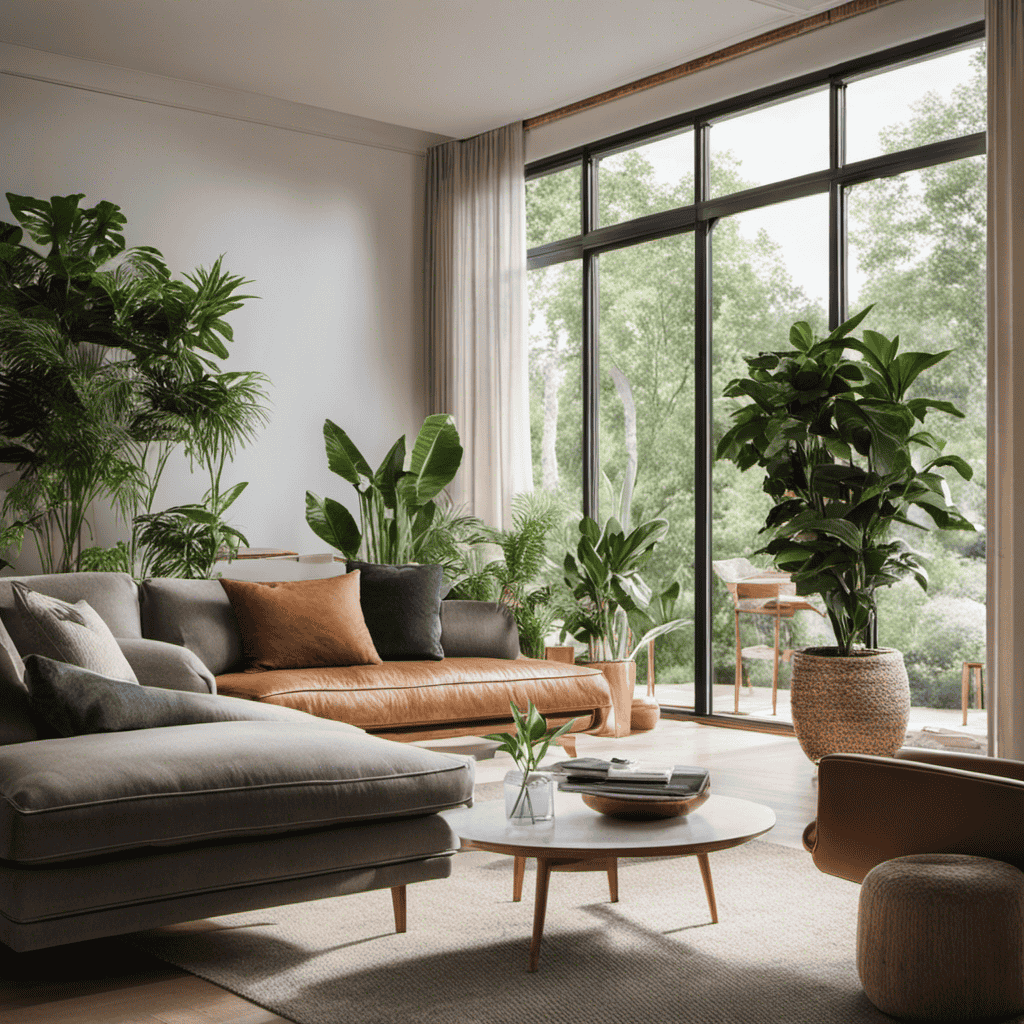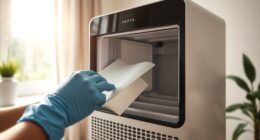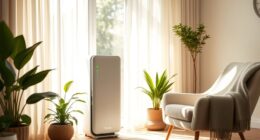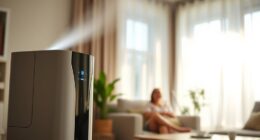I’ve always been curious about the optimal runtime for my air purifier to achieve maximum results. Finding the perfect balance between clean air and energy usage is crucial.
In this article, we’ll explore the benefits of running an air purifier, factors to consider, and the recommended duration for optimal performance. We’ll also discuss how often you should run it, the impact on energy usage, and even how long it takes to clean the air.
So, let’s dive in and find out how long you should run an air purifier for a healthier living space.
Key Takeaways
- The optimal duration for running an air purifier depends on factors such as room size, air pollution level, and purifier type.
- High pollution areas may benefit from running the air purifier continuously.
- Different air purifiers have varying capabilities, so it is important to check the manufacturer’s guidelines for the recommended duration.
- It is recommended to run the air purifier continuously for optimal air quality, but the running time can be adjusted to balance energy consumption and noise during sleep.
Benefits of Running an Air Purifier
Running an air purifier can help reduce allergens and improve indoor air quality. Clean air is essential for maintaining good respiratory health, as it can reduce the risk of respiratory problems and allergies.
Air purifiers work by filtering out pollutants such as dust, pollen, pet dander, and smoke, which can cause irritation and worsen respiratory conditions. By removing these particles from the air, air purifiers create a healthier environment for everyone in the household.
In particular, those with asthma or allergies can benefit greatly from clean air, as it reduces the triggers that can lead to flare-ups and discomfort. Additionally, air purifiers can also help remove harmful chemicals and odors, further improving the overall indoor air quality and promoting better respiratory health.
Factors to Consider When Running an Air Purifier
When it comes to using an air purifier, there are several factors to consider.
One important factor is the duration flexibility of the air purifier. Some models allow you to set a specific time for the purifier to run, while others can be programmed to run continuously. This flexibility is beneficial because it allows you to customize the purifier’s operation based on your needs.
Another factor to consider is the noise level of the air purifier. You want to choose a purifier that operates quietly, especially if you plan to use it in your bedroom or other quiet spaces. A noisy purifier can disrupt your sleep or concentration.
Overall, considering the duration flexibility and noise level of an air purifier is crucial in finding the right model for your specific needs.
Now let’s dive into the recommended duration for running an air purifier.
Recommended Duration for Running an Air Purifier
To optimize the performance of your air purifier, it’s important to consider the recommended duration of use. The optimal duration for running an air purifier depends on various factors, including the size of the room, the level of air pollution, and the type of purifier you have.
Here are three key points to keep in mind when determining the recommended timeframe for running your air purifier:
-
Room size: If you have a smaller room, running the air purifier for a few hours a day may be sufficient. However, for larger rooms or open spaces, it may be necessary to run the purifier for longer periods.
-
Air pollution level: If you live in an area with high pollution levels or have specific air quality concerns, running the purifier for longer durations, even 24/7, may be beneficial.
-
Purifier type: Different air purifiers have varying capabilities and filtration systems. Checking the manufacturer’s guidelines or consulting with an expert can help determine the optimal duration for your specific purifier.
Remember to consider these factors to ensure that you are running your air purifier for the recommended timeframe, maximizing its effectiveness in improving indoor air quality.
How Often Should You Run an Air Purifier
If your indoor air quality is a concern, it’s important to consider how often an air purifier should be used. The frequency of running an air purifier depends on various factors such as the size of the room, the level of pollutants, and personal preferences. Generally, it is recommended to run an air purifier continuously to maintain optimal air quality. However, if you are concerned about energy consumption or noise during sleep, you can adjust the running time accordingly. For example, running the air purifier for a few hours before bed and during the night can help improve sleep quality by reducing allergens and pollutants in the bedroom. Here is a table summarizing the best times to run an air purifier and its impact on sleep:
| Best Times to Run an Air Purifier | Impact on Sleep |
|---|---|
| Before Bed | Reduces allergens and pollutants, promoting better sleep |
| During the Night | Continuously improves air quality, enhancing sleep quality |
| All Day/Night | Maintains optimal air quality, ensuring uninterrupted sleep |
Impact of Running an Air Purifier on Energy Consumption
When considering the impact of running an air purifier on energy consumption, two key points to consider are the energy efficiency of the purifier itself and the cost of continuous operation.
Energy efficiency refers to how effectively the purifier uses energy to clean the air, while the cost of continuous operation refers to the amount of energy consumed over time.
Energy Efficiency of Purifiers
You can save energy by choosing an air purifier with a higher efficiency rating. When it comes to energy saving features, there are a few key things to consider:
-
Energy Star Certification: Look for air purifiers that have been certified by Energy Star. These models meet strict energy efficiency guidelines and can help you save on your electricity bill.
-
Adjustable Fan Speeds: Opt for purifiers that offer adjustable fan speeds. This allows you to choose a lower setting when air quality is better, reducing energy consumption.
-
Low Noise Levels: Some air purifiers can be quite noisy, especially on high settings. Look for models that have low noise levels, so you can enjoy cleaner air without the added disturbance.
Choosing an air purifier with these energy saving features can help you reduce your environmental impact and save money on your energy bills.
Speaking of costs, let’s now explore the cost of continuous operation.
Cost of Continuous Operation
To calculate the cost of running an air purifier continuously, consider the electricity usage and the average cost per kilowatt-hour in your area.
Running an air purifier 24/7 can be costly, but there are energy-saving tips to make it more cost-effective. Firstly, choose an energy-efficient model with a high CADR (clean air delivery rate) and low power consumption. Look for Energy Star certified purifiers, as they meet strict energy efficiency guidelines.
Additionally, consider the size of the room you want to purify. Running a purifier in a smaller space can be more cost-effective than trying to clean a larger area.
Lastly, adjust the fan speed to a lower setting when the air quality is good, which will reduce energy consumption.
Best Times of the Day to Run an Air Purifier
During the day, it’s best to run your air purifier when you’re not in the room. This allows the purifier to do its job effectively without disturbing your activities. However, there are certain times when running an air purifier can have a more significant impact on improving air quality and sleep quality.
Here are the best times to run an air purifier:
-
Before bedtime: Running the air purifier for a few hours before you go to sleep can help remove allergens and pollutants from the air, creating a cleaner environment for better sleep quality.
-
During peak pollution hours: If you live in an area with high pollution levels, running the air purifier during peak pollution hours can help filter out harmful particles and improve the overall air quality in your home.
-
When cooking or cleaning: Running the air purifier while cooking or cleaning can help remove cooking odors and chemical fumes, ensuring a healthier indoor atmosphere.
By running your air purifier at these specific times, you can maximize its effectiveness in improving air quality and promoting better sleep.
Now, let’s explore the different modes of operation for air purifiers.
Different Modes of Operation for Air Purifiers
The different modes of operation for air purifiers include automatic, sleep, and eco modes, each offering unique features to suit your needs.
The continuous mode runs the air purifier constantly, ensuring optimal air quality at all times. This mode is recommended for those with allergies or respiratory issues.
On the other hand, the intermittent mode allows the air purifier to cycle on and off at regular intervals, conserving energy while still maintaining air cleanliness.
Noise levels vary depending on the mode of operation. In automatic mode, the air purifier adjusts its fan speed based on the air quality, resulting in varying noise levels. Sleep mode operates at a quieter setting to promote a peaceful sleep environment. Eco mode optimizes energy efficiency by reducing fan speed and noise.
Transitioning into the next section, let’s explore the question of whether running an air purifier overnight is necessary.
Running an Air Purifier Overnight: Is It Necessary
Running your air purifier overnight can help ensure that you have clean and fresh air to breathe while you sleep. Here are three key benefits of running an air purifier during the day:
-
Removes Allergens: Air purifiers are designed to capture and eliminate allergens such as dust mites, pollen, and pet dander. By running the purifier during the day, you can reduce the amount of allergens in your home, providing relief for allergy sufferers.
-
Eliminates Odors: Air purifiers are also effective at eliminating unpleasant odors caused by cooking, pets, or smoke. By running the purifier during the day, you can ensure that your home smells fresh and clean.
-
Reduces Airborne Germs: Air purifiers with HEPA filters can trap and remove airborne bacteria and viruses. Running the purifier during the day can help reduce the spread of germs and improve indoor air quality.
Overall, running an air purifier during sleep and throughout the day can have numerous benefits, including cleaner air, reduced allergies, and improved overall health.
Can You Run an Air Purifier Continuously
When it comes to air purifiers, one common question is whether they can be run continuously.
In this discussion, we will explore the benefits and considerations of running an air purifier non-stop.
We will also delve into the optimal run time for maximum effectiveness and address any concerns regarding power consumption.
Continuous Air Purifying
To maintain optimal indoor air quality, you should keep your air purifier running continuously. Running your air purifier continuously has several benefits that contribute to a cost-effective operation and improve indoor air quality.
Here are three key reasons why you should run your air purifier continuously:
-
Continuous filtration: By running your air purifier continuously, it ensures that the air in your home is constantly being filtered, removing pollutants such as dust, pollen, pet dander, and mold spores. This helps to improve the overall air quality and reduce the risk of respiratory issues.
-
Constant purification: Running your air purifier continuously ensures that the air is constantly being purified, removing harmful particles and allergens. This is especially important for individuals with allergies or respiratory conditions, as it helps to create a healthier living environment.
-
Energy efficiency: Contrary to popular belief, running your air purifier continuously can be energy efficient. Newer models are designed to operate on low energy settings, allowing them to run continuously without consuming excessive electricity. This ensures that you can enjoy clean air without worrying about high energy bills.
Optimal Run Time
Contrary to popular belief, keeping your air purifier on continuously can be energy efficient. Many people believe that turning off the air purifier when not in use is the best practice to save energy. However, constantly turning the air purifier on and off can actually use more energy and put unnecessary strain on the motor.
By running the air purifier continuously, it can maintain a constant level of air purification without the need for frequent power cycling. Of course, there are potential risks associated with leaving the air purifier on all the time, such as increased power consumption and the need for more frequent filter replacements. However, with proper maintenance and regular filter changes, the benefits of continuous air purification can outweigh these concerns.
Now, let’s address power consumption concerns.
Power Consumption Concerns?
If you’re worried about power consumption, there are ways to mitigate the energy usage of your continuously running air purifier. Here are some energy saving tips to consider:
-
Use a timer: Set your air purifier to run only when needed. This way, you can reduce the amount of time it operates and save on electricity.
-
Optimize filter replacements: Regularly clean or replace the filters in your air purifier to maintain its efficiency. Clogged filters can make the device work harder, consuming more energy.
-
Consider noise level concerns: Some air purifiers can be noisy, especially at higher fan speeds. Look for models with a noise level that suits your preference, so you can run it without disruption.
Running an Air Purifier in Different Seasons
During different seasons, you’ll want to adjust the settings on your air purifier to optimize its performance.
When running an air purifier at high altitude, it’s important to take into consideration the decrease in air density. This means that the air purifier may need to run at a higher fan speed to effectively circulate and purify the air.
Additionally, running an air purifier in a humid environment requires special attention. High humidity levels can promote the growth of mold and mildew, which can reduce the effectiveness of the air purifier. In this case, it’s recommended to use an air purifier with a built-in dehumidifier or to maintain proper ventilation to prevent excess moisture.
Running an Air Purifier in Different Room Sizes
When it comes to running an air purifier in different room sizes, it’s important to consider the size of the room in order to determine whether a small room purifier or a large room purifier would be more effective.
A small room purifier is designed to clean the air in spaces up to 300 square feet, while a large room purifier is capable of purifying air in spaces up to 700 square feet.
Choosing the right size purifier for your room is crucial in ensuring optimal air purification and maintaining a healthy indoor environment.
Small Room Purifier
You’ll want to run an air purifier in a small room for at least 4-6 hours a day. This ensures that the air in your room remains clean and free from pollutants.
Here are some cost-effective options for small room air purifiers:
-
Compact size: Look for air purifiers specifically designed for small rooms, as they are more energy-efficient and can effectively clean the air in a smaller space.
-
Low noise levels: Opt for purifiers with noise levels below 50 decibels, especially if you plan to run it during the night. This will help maintain a peaceful environment and ensure a good night’s sleep.
-
Sleep mode: Some air purifiers have a sleep mode feature that reduces noise levels and turns off any bright lights, allowing you to sleep undisturbed.
Running an air purifier in a small room can greatly improve the air quality and create a healthier living environment. But what about larger rooms? Let’s find out.
Large Room Purifier?
In larger rooms, it’s important to choose an air purifier that is specifically designed to effectively clean the air in a bigger space. These air purifiers have a larger coverage area and higher air flow rate to ensure optimal performance. When selecting a large room air purifier, consider the noise level as well. A noisy air purifier can be disruptive, especially if you plan to use it in a bedroom or office. Look for models that have a low noise level, typically measured in decibels (dB). To help you make an informed decision, here is a table comparing three popular large room air purifiers:
| Air Purifier Model | Large Room Coverage | Noise Level (dB) |
|---|---|---|
| Model A | 500 square feet | 35 dB |
| Model B | 700 square feet | 40 dB |
| Model C | 1000 square feet | 45 dB |
Remember to consider both the coverage area and noise level when selecting an air purifier for your large room.
How Long Does It Take for an Air Purifier to Clean the Air
It doesn’t take too long for an air purifier to clean the air. In fact, most air purifiers can remove the majority of airborne pollutants within a few hours. To give you a better idea of the time it takes, here are three factors that can affect the cleaning process:
-
Room size: The larger the room, the more time it may take for the air purifier to clean the air completely. It’s important to choose a purifier that is suitable for the size of your space.
-
Air quality: If the air in your home is heavily polluted, it may take longer for the purifier to remove all the contaminants. Regular maintenance and filter replacements can help maintain optimal performance.
-
Purifier efficiency: Different air purifiers have varying levels of efficiency. Higher-end models with advanced filtration systems can clean the air faster and more effectively.
When it comes to impact on indoor plants, air purifiers generally have minimal effect. As for noise level comparison, some air purifiers can be quite quiet, especially on lower fan speeds. It’s always a good idea to check the noise level specifications before purchasing to ensure it meets your preference.
Running an Air Purifier in a Pet-Friendly Household
If you have pets at home, make sure to clean your air purifier regularly to remove any pet hair or dander that may accumulate. Running an air purifier in a pet-friendly household is essential to maintain clean and fresh indoor air quality. Pets can shed hair and dander, which can trigger allergies or asthma symptoms in some individuals. To keep your air purifier running efficiently, it is recommended to follow a maintenance routine specifically designed for pet owners. Here is a helpful table outlining the recommended maintenance for pet-friendly households:
| Maintenance Task | Frequency |
|---|---|
| Change or clean filters | Every 3-6 months |
| Vacuum pre-filter | Weekly |
| Wipe down exterior | Monthly |
| Clean internal components | Annually |
Running an Air Purifier During Allergy Season
When it comes to running an air purifier during allergy season, two key factors to consider are optimal purifier runtime and effectiveness against allergens.
Determining the optimal purifier runtime depends on the severity of allergens in your home and your specific needs.
Additionally, it is important to choose an air purifier that has proven effectiveness in removing allergens such as pollen, pet dander, and dust mites.
Optimal Purifier Runtime
To ensure the air in your home remains clean and fresh, you should run your air purifier for at least 8 hours a day. Here are three reasons why maintaining this optimal purifier runtime is beneficial:
-
Improved Indoor Air Quality: Running your air purifier for a sufficient amount of time helps remove pollutants such as dust, pollen, and pet dander from the air, leading to cleaner and healthier indoor air.
-
Allergy and Asthma Relief: By continuously filtering and trapping allergens, air purifiers can provide relief for individuals suffering from allergies or asthma, reducing symptoms and improving overall respiratory health.
-
Odor Elimination: Air purifiers equipped with activated carbon filters can effectively eliminate unpleasant odors from cooking, pets, or smoke, leaving your home smelling fresh and clean.
Effectiveness Against Allergens?
Air purifiers are effective in reducing allergens such as dust, pollen, and pet dander from the air. They play a crucial role in improving respiratory health by removing these potential irritants that can trigger allergies and asthma symptoms. These devices work by capturing and trapping airborne particles through various filtration methods, such as HEPA filters.
Multiple studies have shown the positive impact of air purifiers on respiratory health. For example, a study published in the Journal of Allergy and Clinical Immunology found that using an air purifier reduced indoor particulate matter and improved lung function in children with asthma.
Furthermore, air purifiers are also effective against other pollutants like smoke, mold spores, and volatile organic compounds (VOCs), providing a cleaner and healthier indoor environment.
What to Do When the Air Quality Improves: Should You Still Run the Air Purifier?
Even if the air quality improves, you should still run the air purifier to maintain a clean environment. Here’s why:
-
Running an air purifier during cold and flu season: Cold and flu viruses can linger in the air for hours, increasing the chances of getting infected. An air purifier with a HEPA filter can effectively capture and remove these viruses, reducing the risk of transmission.
-
Running an air purifier in a high pollution area: Living in a high pollution area exposes you to harmful pollutants like fine particles, volatile organic compounds (VOCs), and gases. An air purifier with activated carbon filters can help remove these pollutants, improving the air quality and protecting your health.
-
Continuous protection: Even if the air quality improves, there can still be pollutants present that are not visible to the naked eye. Running an air purifier ensures that these invisible pollutants are continuously filtered out, providing you with a clean and healthy living environment.
Frequently Asked Questions
Can Running an Air Purifier Improve the Air Quality in a Pet-Friendly Household?
Running an air purifier in a pet-friendly household can greatly improve air quality. The benefits of air purifiers for pets include reducing pet dander, allergens, and odors, creating a healthier environment for both humans and animals.
Should You Run an Air Purifier Continuously or Only at Certain Times?
I find that running an air purifier continuously has its benefits, as it helps maintain clean air consistently. However, there are also advantages to running it intermittently, such as during specific times when allergens or pollutants are more prevalent.
How Long Does It Take for an Air Purifier to Clean the Air in a Room?
It typically takes an air purifier a few hours to effectively remove smoke particles from the air in a room. Additionally, using an air purifier can help reduce allergens and improve air quality.
Is It Necessary to Run an Air Purifier Overnight?
Running an air purifier all night is safe and can improve indoor air quality. However, it may slightly increase your electricity bill. It’s important to consider factors like room size and air quality needs when deciding how long to run an air purifier.
What Should You Do When the Air Quality Improves? Should You Still Run the Air Purifier?
Even when the air quality improves, it’s still worth running an air purifier. It helps remove allergens, pollutants, and odors, creating a healthier and more comfortable environment. The benefits outweigh the cost.
Conclusion
In conclusion, running an air purifier can greatly improve the air quality in your home, providing numerous benefits for you and your family.
Factors such as the size of your space and the specific needs of your household should be considered when determining how long to run the purifier.
While energy consumption may increase, the health benefits outweigh the costs.
So, why not invest in an air purifier to create a cleaner and healthier environment for yourself and your loved ones?
